| BOUNDARY LINE BETWEEN EASTERN AND CENTRAL ZONES. 51 I.C.C. 273 | |
|---|---|
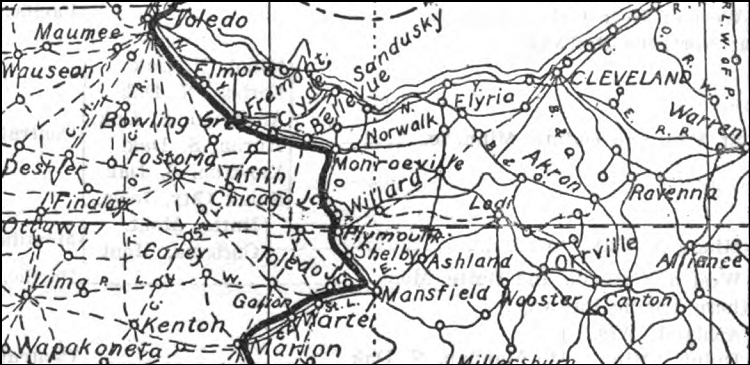 The original time zone boundary through northern Ohio. The boundary above was officially in effect January 1 through June 1, 1919. | |
|
On March 19th, 1918, Congress established time zones in the US and gave the task of defining the boundaries of those zones to the Interstate Commerce Commission. The ICC quickly put in place boundaries based on local customs and started the process of establishing official time zone boundaries. On October 24, 1918, the ICC established time zone boundaries including the boundary shown on this page - dividing Eastern Time and Central Time. The initial boundaries were drawn following natural divisions including rivers and mountain ridges but the most common division on the initial map were railroads. Many boundaries followed railroads, running parallel to their tracks. These boundaries divided cities, including Toledo and Columbus Ohio, placing one side of the tracks in one time zone and the tracks and the other side of the tracks in another time zone. There were explicit exceptions for railroads that extended across the defined lines. Under the exceptions the railroad operates using the neighboring time zone while publicly showing the time for arrival and departure of trains in the correct time for the zone where the track is located. The following text officially describes the boundary between Eastern and Central time, with a sketch of that course on the adjacent maps. This boundary took effect January 1, 1919, at 2am. (See the bottom of this page for changes made effective June 1, 1919.) | |
Michigan. -- Beginning on the boundary line between the United States and Canada east of Port Huron, Mich., thence southerly along the international boundary line through the St. Clair River, Lake St. Clair, Detroit River, and Lake Erie to the intersection of the international boundary line with the line between Ohio and Michigan; thence westerly along the north line of Ohio to North Cape, Mich.; thence through Maumee Bay and Maumee River to Toledo, Ohio.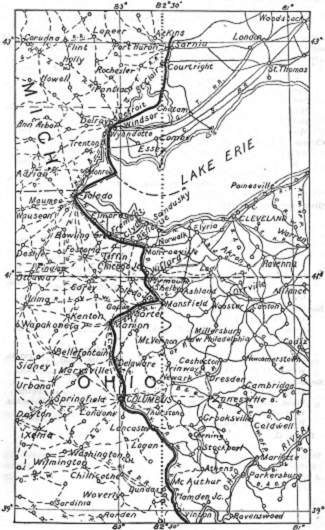 Ohio. -- From Toledo southerly and easterly immediately south and west of and parallel with the New York Central Railroad to Monroeville, crossing in said course the Lake Erie & Western Railroad at Fremont, the Cleveland, Cincinnati, Chicago & St. Louis Railway at Clyde, the New York, Chicago & St. Louis Railroad and the railway of the Pennsylvania Company at Bellevue; thence southerly and immediately west of and parallel with the Baltimore & Ohio Railroad to Toledo Junction, crossing in said course the Baltimore & Ohio Railroad at Willard, the Northern Ohio Railway at Plymouth, and the Cleveland, Cincinnati, Chicago & St. Louis Railway at Shelby Junction, and the Toledo division of the Pennsylvania Company at Toledo Junction; thence westerly and immediately north of and parallel with the Pittsburgh, Fort Wayne & Chicago line of the Pennsylvania Company to Crestline; thence crossing the Cleveland, Cincinnati, Chicago & St. Louis Railway and the railway of the Pennsylvania Company, and thence southerly and westerly and immediately north and west of and parallel with the Cleveland, Cincinnati, Chicago & St. Louis Railway to Galion; thence southerly and westerly and immediately north and west of and parallel with the Erie Railroad to Marion, crossing in said course the eastern division of the Toledo & Ohio Central Railway at Martel; thence crossing the Erie Railroad and the Cleveland, Cincinnati, Chicago & St. Louis Railway; thence southerly and immediately east of and parallel with the Sandusky division of the railway of the Pennsylvania Company to Columbus, crossing in said course the Cleveland, Cincinnati, Chicago & St. Louis Railway at Delaware; thence crossing the railway of the Pennsylvania Company, the Toledo & Ohio Central Railway, the Hocking Valley Railway, and the Baltimore & Ohio Railroad; thence southerly and easterly and immediately west and south of and parallel with the Hocking Valley Railway to Gallipolis, crossing in said course the Norfolk & Western Railway at Valley Crossing, the railway of the Pennsylvania Company at Lancaster, and the Hocking Valley Railway and the Baltimore & Ohio Railroad at Dundas; thence following the Ohio River along the line between Ohio and West Virginia southerly and westerly to the junction of the states of Ohio, West Virginia, and Kentucky. Ohio. -- From Toledo southerly and easterly immediately south and west of and parallel with the New York Central Railroad to Monroeville, crossing in said course the Lake Erie & Western Railroad at Fremont, the Cleveland, Cincinnati, Chicago & St. Louis Railway at Clyde, the New York, Chicago & St. Louis Railroad and the railway of the Pennsylvania Company at Bellevue; thence southerly and immediately west of and parallel with the Baltimore & Ohio Railroad to Toledo Junction, crossing in said course the Baltimore & Ohio Railroad at Willard, the Northern Ohio Railway at Plymouth, and the Cleveland, Cincinnati, Chicago & St. Louis Railway at Shelby Junction, and the Toledo division of the Pennsylvania Company at Toledo Junction; thence westerly and immediately north of and parallel with the Pittsburgh, Fort Wayne & Chicago line of the Pennsylvania Company to Crestline; thence crossing the Cleveland, Cincinnati, Chicago & St. Louis Railway and the railway of the Pennsylvania Company, and thence southerly and westerly and immediately north and west of and parallel with the Cleveland, Cincinnati, Chicago & St. Louis Railway to Galion; thence southerly and westerly and immediately north and west of and parallel with the Erie Railroad to Marion, crossing in said course the eastern division of the Toledo & Ohio Central Railway at Martel; thence crossing the Erie Railroad and the Cleveland, Cincinnati, Chicago & St. Louis Railway; thence southerly and immediately east of and parallel with the Sandusky division of the railway of the Pennsylvania Company to Columbus, crossing in said course the Cleveland, Cincinnati, Chicago & St. Louis Railway at Delaware; thence crossing the railway of the Pennsylvania Company, the Toledo & Ohio Central Railway, the Hocking Valley Railway, and the Baltimore & Ohio Railroad; thence southerly and easterly and immediately west and south of and parallel with the Hocking Valley Railway to Gallipolis, crossing in said course the Norfolk & Western Railway at Valley Crossing, the railway of the Pennsylvania Company at Lancaster, and the Hocking Valley Railway and the Baltimore & Ohio Railroad at Dundas; thence following the Ohio River along the line between Ohio and West Virginia southerly and westerly to the junction of the states of Ohio, West Virginia, and Kentucky. | |
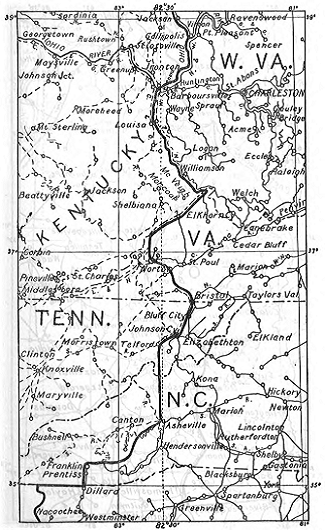 West Virginia-Kentucky. -- From the junction of said state lines along the line between West Virginia and Kentucky southerly to its intersection with the line between Kentucky and Virginia. West Virginia-Kentucky. -- From the junction of said state lines along the line between West Virginia and Kentucky southerly to its intersection with the line between Kentucky and Virginia.Virginia. -- From the intersection of said state lines southwesterly following the line between Kentucky and Virginia to the west line of Dickinson county, Va.; thence southerly along said county line to its intersection with Indian Creek; thence southerly along Indian Creek to Norton; thence crossing the connection between the Norfolk & Western Railway, Southern Railway, and Louisville & Nashville Railroad southeasterly through Dungannon, and there crossing the Carolina, Clinchfield & Ohio Railway to Mendota; thence easterly and southerly and immediately north and east of and parallel with the Southern Railway to Bristol, Va.-Tenn. Tennessee-North Carolina. -- At Bristol crossing the connection between the Southern Railway and the Norfolk & Western Railway, and thence southerly and westerly immediately south and east of and parallel with the Southern Railway to Telford, Tenn., crossing in said course the Carolina, Clinchfield & Ohio Railway at Johnson City, Tenn.; thence southerly to Asheville, N. C., there crossing the Southern Railway; thence southwesterly along Pisgah Ridge to the east boundary of Jackson county, N. C.; thence southwesterly to the northern terminus of the Tallulah Falls Railway at Franklin, N. C.; thence southerly and immediately west of and parallel with said last-mentioned railway to the north boundary of Georgia. | |
|
Georgia. -- From the last-mentioned point west along said state boundary line to the east line of Union county, Ga.; thence southerly along the east lines of Union, Lumpkin, Dawson, and Forsyth counties and the south line of Milton county, Ga., to the eastern line of Cobb county, Ga.; thence southerly to Atlanta, there crossing the Southern Railway and the Seaboard Air Line Rail way; thence southeasterly and immediately south and west of and parallel with the line of the Southern Railway to Macon, there crossing the Central of Georgia Railway; thence southerly and immediately west of and parallel with the Georgia Southern & Florida Railway to Sofkee; thence southerly to the connection of the Central of Georgia Railway and the Ocilla Southern Railroad at Perry; thence southwesterly to the southwest corner of Houston county; thence southerly and westerly along the southern boundary of Macon county to the Central of Georgia Railway; thence Southerly and immediately east of and parallel with said last-mentioned railway to Americus; thence crossing the Seaboard Air Line Railway, southerly and immediately east of and parallel with the Central of Georgia Railway to Albany, there crossing the connection between the Seaboard Air Line Railway, Central of Georgia Railway, Atlantic Coast Line Railroad, Georgia Northern Railway, and the Georgia Southwestern & Gulf Railway; thence southerly immediately west of and parallel with the Atlantic Coast Line Railroad to the north boundary of Florida crossing in said course the Atlantic Coast Line Railroad at Thomasville. Florida. -- From the last-mentioned point westerly along the line between Georgia and Florida to the Apalachicola River; thence southerly along the main channel of the Apalachicola River to Apalachicola Bay and the Gulf of Mexico. 51 I.C.C. 499 Order defining limits of standard time zones, 51 I. C. C., 273, modified so as to include Apalachicola, Fla., within the limits of the Eastern standard time zone. | 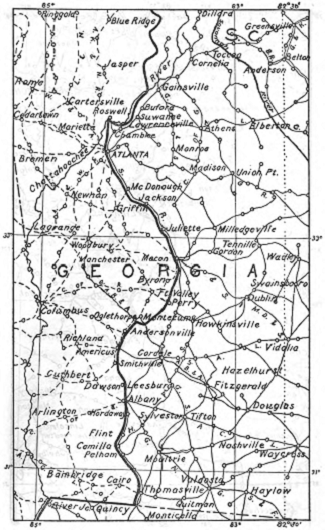 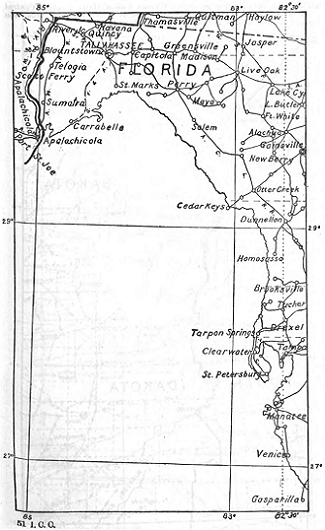
|
53 I.C.C. 208 On May 12, 1919, the Interstate Commerce Commission modified the boundary through Ohio. The new boundary was drawn east of Toledo using the west Erie County line. The line was also moved east from Mansfield south to the Ohio River, placing the Columbus area entirely in Central Time instead of having the line run through the city. The boundary below became effective June 1, 1919.  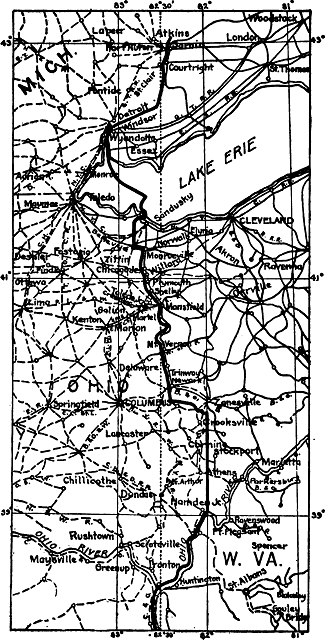 Michigan-Ohio. -- Beginning on the boundary line between the United States and Canada east of Port Huron, Mich.; thence southerly and easterly along the international boundary line through the St Clair River, Lake St. Clair, Detroit River, and Lake Erie to the intersection of the International boundary line with
the line between Ottawa county and Erie county, Ohio; thence southerly along the western boundary of Erie county and of Huron county, Ohio, to Bellevue, crossing in said course the New York Central Railroad near Bay Ridge, the Lake Erie & Western Railroad, and the Cleveland, Cincinnati, Chicago & St. Louis Railway; thence crossing the New York Central Railroad, the Wheeling & Lake Erie Railway, and the line of the Pennsylvania Company at Bellevue; thence easterly immediately south of and parallel with the New York Central Railroad to Monroeville;
thence southerly Immediately west of and parallel with the Baltimore & Ohio Railroad to the northern boundary line of Perry county, near Bruno, crossing in said course the Baltimore & Ohio Railroad at Wlllard, the Northern Ohio Railway at Plymouth, the Cleveland, Cincinnati, Chicago & St. Louis Railway at Shelby Junction, the Chicago division of the Pennsylvania Company, and the Erie Railroad at Mansfield, the lines of the Pennsylvania Company at Mt. Vernon and Newark, and the line of the Baltimore & Ohio at Newark; thence easterly and southerly along the boundary line between Perry county and Licking and Muskingum counties to the northwest corner of Morgan county, crossing in said course the Baltimore & Ohio Railroad near Bruno, the Zanesvllle & Western Railway near Fultonham and East Fultonham, and the Zanesvllle division of the Pennsylvania Company at Roseville; thence easterly along the northern boundary line of Morgan county to the Meridian 82° west; thence south along said meridian to the Ohio River, crossing in said course the Federal Valley Railroad at Lewis and the Baltimore & Ohio Railroad at Canaanvllle; thence following the Ohio River along the line between Ohio and West Virginia southerly and westerly to the junction of the states of Ohio, West Virginia, and Kentucky.
Michigan-Ohio. -- Beginning on the boundary line between the United States and Canada east of Port Huron, Mich.; thence southerly and easterly along the international boundary line through the St Clair River, Lake St. Clair, Detroit River, and Lake Erie to the intersection of the International boundary line with
the line between Ottawa county and Erie county, Ohio; thence southerly along the western boundary of Erie county and of Huron county, Ohio, to Bellevue, crossing in said course the New York Central Railroad near Bay Ridge, the Lake Erie & Western Railroad, and the Cleveland, Cincinnati, Chicago & St. Louis Railway; thence crossing the New York Central Railroad, the Wheeling & Lake Erie Railway, and the line of the Pennsylvania Company at Bellevue; thence easterly immediately south of and parallel with the New York Central Railroad to Monroeville;
thence southerly Immediately west of and parallel with the Baltimore & Ohio Railroad to the northern boundary line of Perry county, near Bruno, crossing in said course the Baltimore & Ohio Railroad at Wlllard, the Northern Ohio Railway at Plymouth, the Cleveland, Cincinnati, Chicago & St. Louis Railway at Shelby Junction, the Chicago division of the Pennsylvania Company, and the Erie Railroad at Mansfield, the lines of the Pennsylvania Company at Mt. Vernon and Newark, and the line of the Baltimore & Ohio at Newark; thence easterly and southerly along the boundary line between Perry county and Licking and Muskingum counties to the northwest corner of Morgan county, crossing in said course the Baltimore & Ohio Railroad near Bruno, the Zanesvllle & Western Railway near Fultonham and East Fultonham, and the Zanesvllle division of the Pennsylvania Company at Roseville; thence easterly along the northern boundary line of Morgan county to the Meridian 82° west; thence south along said meridian to the Ohio River, crossing in said course the Federal Valley Railroad at Lewis and the Baltimore & Ohio Railroad at Canaanvllle; thence following the Ohio River along the line between Ohio and West Virginia southerly and westerly to the junction of the states of Ohio, West Virginia, and Kentucky.57 I.C.C. 455 - 1920 Order defining limits of standard Eastern time zone, 53 I.C.C. 208, modified so as to include Mount Vernon, Ohio, within the standard Eastern time zone. 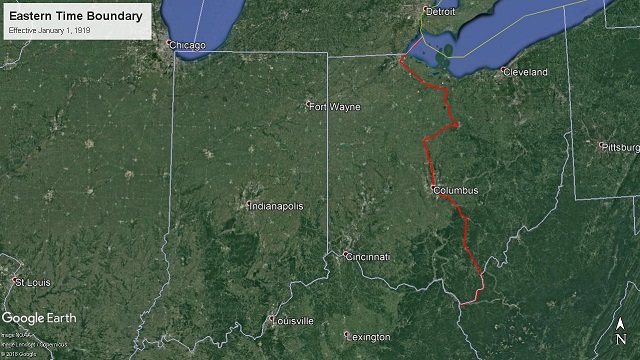 Effective Jan 1 - June 1, 1919  Effective June 1, 1919 - April 1, 1922 | |
| 1922-1927 > | |